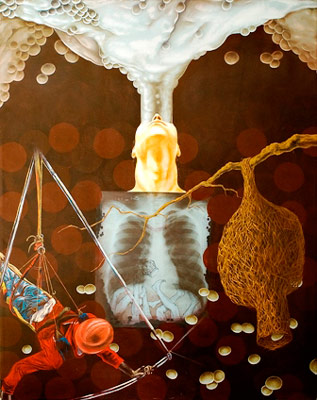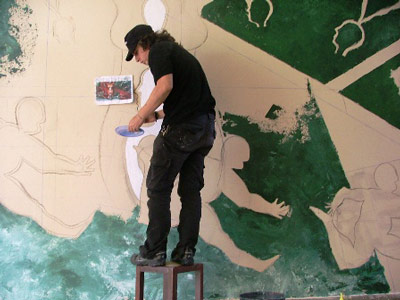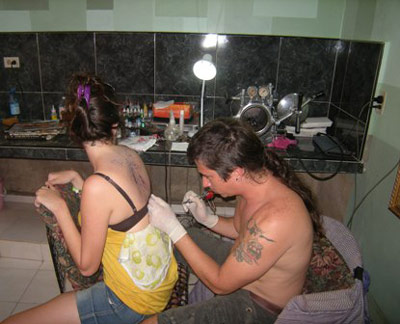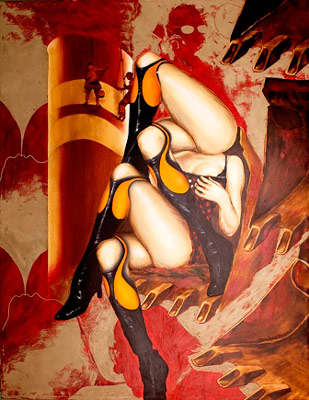Painting Canvases, Bodies and Souls
An Interview with Cuban Painter Jose Rene Blanco
Dariela Aquique

HAVANA TIMES — Art has always reflected the most distinctive characteristics of the historical period in which it has been produced. Portraits, landscapes, sea vistas, figurative and abstract pieces: all have invariably sought to capture their times through different styles. My interviewee, painter and tattoo artist Jose Rene Blanco Salermo (affectionaly known as “El Bola”), paints canvases and human bodies. A dreamer, he also paints souls.
HT: Did you study painting at an arts academy?
JB: I studied at an arts academy for a very short time. I didn’t finish my studies, actually. I was there for only a year. I head to drop out because of personal problems I had at the time. What I learned there was to value the fine arts. Before I got there, I knew practically nothing about art. I had been drawing and painting since I was a kid, but for spiritual reasons, really, because I was good at it and I had fun doing it. But I had never thought about doing a career in that, no.
I discovered my true calling at the art institute, I think. I don’t consider myself a formally trained artist, however, and not only because I don’t have a degree, but because I was painting before art school and I continued to paint afterwards. It’s something inside me, something you could say I was born with. Also, I feel that I don’t follow the academy’s rules, and that this is why I arrived at my own way of painting more quickly, because I had less prejudices, because I was less influenced by classical canons. This has given me a bit more freedom while painting. Knowing the basic rules while being conscious that you can break these, change them, this is what motivates me.

HT: Being a self-trained artist, has this made it more difficult for you to promote your work?
JB: It’s been bad for me, to a certain extent, but it’s also brought me good things. For instance, it’s given me the freedom to paint without having to obey certain conventions. On the other hand, ironically, after several years of work as a professional painter, after so many local, nationwide and international exhibitions, after donating so many murals to the city, I am still not officially registered as an artist, that is, I still don’t have the right to sell my work – I am only allowed to do this when I hold an exhibition. To a certain extent, this has been good for me, because it’s forced me to sell my works at home.
Many artist friends tell me that, sometimes, it’s better not to be registered as an artist, because of all the hurdles you run into to make a living from your art, because of the red tape and tax requirements, which are a little twisted. In any event, I imagine that, at some point, they’ll require artists like me to acquire a license to sell their pieces. So, it’s relative – it’s got good things and bad things.
HT: What organization or institution have you joined to be able to exhibit and sell your pieces?
JB: Well, here in Santiago de Cuba, when you’ve already made a good many pieces, you submit an application to join these organizations and, if your work has quality, you’re almost always accepted. I belong to the Provincial Fine Arts Council and the Hermanos Saiz Association (AHS). Incidentally, I’m already a bit too old to be a member there. I’ve submitted my application to become a member of the Cuban Writers and Artists Association (UNEAC). The board of experts in the province has approved my application twice already, but, when the application gets to Havana, they turn me down. I don’t know why. It’s all very centralized, there’s regionalism and all that.

HT: What techniques do you employ the most?
JB: I like using acrylics very much. I also use oil and charcoal, always on canvas. I’ve also wanted to work with asphalt, because of its color and texture, which gives you some really incredible results. I very much like lithography, though I haven’t been able to do as many lithographs as I’ve wanted. It requires a workshop and a series of materials that aren’t within my reach. Lithography is a very beautiful process. I would also love to do sculptures, but I don’t have the materials for it. That restricts you in terms of the techniques you want to try.
HT: What pictorial style do you like the most, and why?
JB: I would like to paint abstract pieces, but I think I won’t ever stop painting figurative works, because nature has so much diversity, offers you so many forms and movement, that I don’t think I’d be able to paint all of the figurative works I want to, not even with all of the time in the world at my disposal. I describe myself as a surrealist. My paintings are “metaphysical” (not in terms of the technical concepts used to define metaphysical painting, merely from my own point of view). They are absurdist, in my opinion. In fact, I combine different elements without limits in my universes.

I like playing conceptually with the different states of matter. You could call me a landscape artist, because I paint man’s inner landscapes, vistas which become the external expressions of an inner world, a whole universe.
I combine different styles. I like expressionism and impressionism very much. I am passionate about graphic design, and I try to combine all of these elements in my work.
HT: Oils, acrylics, brushes, easels and other art supplies aren’t readily available anywhere. How do you get your supplies?
JB: Well, they’ve got a store that sells art supplies to artists here. They’re not often stocked and many supplies are scarce. They draw up a list which of course prioritizes certain personalities, members of UNEAC. I’ve bought large quantities of art supplies, to build up a stock, whenever I’ve had the opportunity to buy with a friend’s membership code. You know how we Cubans do things, always fearing things will run out quickly. Other times, I’ve had to buy things on the black market.

HT: Tattoo art became more widespread and popular during Cuba’s War of Independence. It became a profession. Do you consider tattoo art your other profession?
JB: Yes, I can paint anything: a canvas, a body, a wall, a plane, an animal. I am a painter, and tattooing is a form of painting. The only difference is that it’s done on skin.
HT: In recent years, tattoos have become more socially acceptable, to the point that, today, one could say they have purely aesthetic ends and do not set different social sectors apart. Some prejudices still remain, however. Why do you think this is?
JB: What you can tattoo on someone is truly unimaginable; I’ve seen true works of art tattooed on people’s bodies. People still harbor those prejudices because they’ve been unable to appreciate the beauty of some tattoos. It’s a hedonistic work of art which can’t exactly be sold – though there are people around the world that are including their skins in their wills, so as to pass on their tattoos after their deaths. So, you can imagine the tattoos we’re talking about.

HT: Are you involved in any new projects?
JB: No, I don’t really have projects. I just paint and, after I’ve finished a certain number of works, I start to look for some relationship between them. This is quite difficult, actually. What do these works have in common? That’s how I start to think about having an exhibition. Curators are always telling me I can’t put certain pieces together, that they’re not related in the least, and it’s difficult to convince them. Ultimately, I don’t want to convince them or the public. I just want to shake people up a bit.
HT: Why do you paint both canvases and bodies?
JB: For me, it’s therapeutic. I feel like I’m creating parallel universes and alternate worlds, multi-polar, ancient and futuristic. I express myself through canvases and bodies. I speak of life and death between the Caribbean’s hurricane seasons, or a place where you can stop to wait for an imaginary carriage to take you away somewhere.
